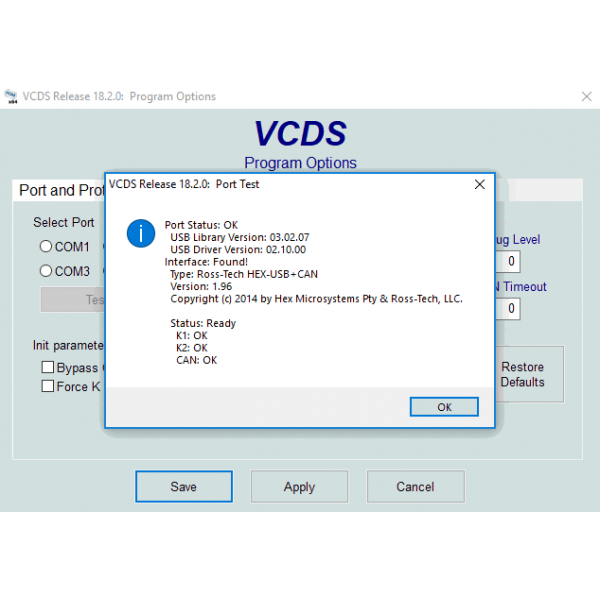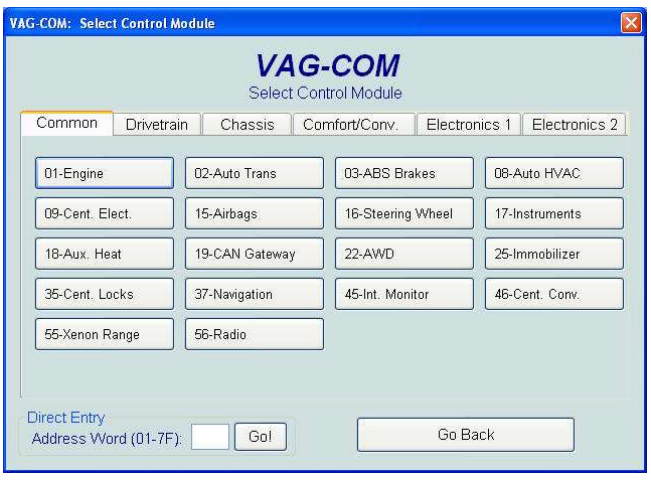

- #How to use vcds serial#
- #How to use vcds software#
- #How to use vcds code#
- #How to use vcds simulator#
the list is cached while connected to the vehicle.Ĭurrently, you can get active DTCs (incomplete can split DTCs, but dumps raw hex), load VCDS-compatible labels, and read known blocks (Not yet) Running Traces In a similar (but more primitive) manner to VCDS's "Auto-Scan" (but without recording anything other than the part number yet)Īny operation involving a module, must first enumerate available modules. Once in the OEM enhanced menu, the option to "Enumerate Modules" is shown this attempts to connect to every known module in-turn KWP1282 protocol, in KWP2000 Measuring Blocks are just parameters to readDataByLocalIdentifier. VW seems to use "Blocks" for everything, which is a holdover term from the old It's a fairly standard implementation of the KWP2000 application layer over CAN, just usingĪ proprietary transport protocol instead of ISO-TP. The "OEM Enhanced" menu utilizes the VIN gathered over OBD-2 to determine the appropriate protocol and menu to use.įor Volkswagen, this is VWTP/KWP. The basic menu supports CAN/OBD-2 commands, such as retrieving the VIN or powertrain/emmisions DTCs (Not yet the latter.) Getting started with this toolkit simply involves running diag.py in a terminal.
#How to use vcds code#
allows testing code for crashes with "known good" responses from the ECU.

it can be configured to spit arbitrary data back at the tester in response to a query. It is a more sophisticated integration test, however.
#How to use vcds simulator#
Unfortunately, the basic simulator used for initial testing is not advanced enough for testing much of anything aside from the basic measurement blocks and communication protocols (and the "ECU ID" request) The one used for working the initial kinks out of the VWTP stack is vag-diag-sim, although others can be used (such as a real "ECU in a box" simulator)
#How to use vcds software#
In order to test the features of the software without needing to have a car hooked up, a socketCAN equiped ECU simulator can be used.
Contributions to vag-diag-sim to support more KWP functions and crash less. note: this will NEVER support OBD2 due to potential misuse! "Session hijacking" using an external scan tool. Better error handling (at least it now cleanly disconnects when an exception is thrown.). "Long Codes" (Likely just KWP data blocks just need a trace of the service being called from someone who has a hexcan and CAN sniffer). UDF (Newer VWs will likely shim on top of scapy since it already has a maintained implementation). support for K-line (Low priority, since old, and VCDS unregistered can use cheap 3rd-party adapters for K-line stuff). More measurement block units and scaling code. Tracing of "raw" VWTP transactions used for investigating internal CAN bus traffic on VWs (usually, proto != 1 traffic). Tracing of VWTP/KWP transactions used for black-box testing with other scan tools. Reading measurement block labels from plaintext ross-tech label files. #How to use vcds serial#
Retreival of serial numbers, VIN and other module information from ECUs (just parameters to readEcuIdentification).Enumeration of available ECUs for connection (works.
 KWP2000 (synchronous operation only, periodic responses are not supported). VWTP 2.0, AKA "TP20", the underlying transport used in all CAN VWs. The officially tested adapter hardware is a CANdleLight board (STM32F072) running the candleLight_fw any adapter that works with the aformentioned software (ie: NOT a hex-can or ELM327). officially tested on linux and socketCAN. earlier versions have numerous bugs around raw CAN transport, which includes the clones. If you NEED to use CLB labels, buy a hex-can and use VCDS. I may document the file format, but key material and/or decryptors will The entire purpose of CLB files is to prevent competitors from trivially using them, and therefore I will NEVER CLB LABELS ARE NOT, AND WILL NEVER BE SUPPORTED. As an alternative, this software can read plaintext labelsĪnd build a local cache from ross-tech's files. That are present in ross-tech's label database. I AM NOT AFFILIATED WITH ROSS-TECH IN ANY WAY, AND HAVE NOT USED ANY VCDS MATERIAL IN THIS PROGRAM.ĭue to the "easy availability" of Ross-tech's labels, I will NOT be including any labels I AM NOT RESPONSIBLE IF YOU DAMAGE, BRICK, OR OTHERWISE IMPACT OPERATION OF YOUR CAR (such as, but NOT LIMITED TO using untested or experimental features such as long-coding) PyVCDS is an attempt at implementing an open-source and cross-platform alternative to VCDS, using information that is freely available on the internet, and experimentation on an old (2007.) VW.įirst off, the usual NO WARRANTY EXPRESSED OR IMPLIED, INCLUDING MERCHANTABILITY OR FITNESS FOR A PARTICULAR PURPOSEĪnd THIS IS EXPERIMENTAL SOFTWARE.
KWP2000 (synchronous operation only, periodic responses are not supported). VWTP 2.0, AKA "TP20", the underlying transport used in all CAN VWs. The officially tested adapter hardware is a CANdleLight board (STM32F072) running the candleLight_fw any adapter that works with the aformentioned software (ie: NOT a hex-can or ELM327). officially tested on linux and socketCAN. earlier versions have numerous bugs around raw CAN transport, which includes the clones. If you NEED to use CLB labels, buy a hex-can and use VCDS. I may document the file format, but key material and/or decryptors will The entire purpose of CLB files is to prevent competitors from trivially using them, and therefore I will NEVER CLB LABELS ARE NOT, AND WILL NEVER BE SUPPORTED. As an alternative, this software can read plaintext labelsĪnd build a local cache from ross-tech's files. That are present in ross-tech's label database. I AM NOT AFFILIATED WITH ROSS-TECH IN ANY WAY, AND HAVE NOT USED ANY VCDS MATERIAL IN THIS PROGRAM.ĭue to the "easy availability" of Ross-tech's labels, I will NOT be including any labels I AM NOT RESPONSIBLE IF YOU DAMAGE, BRICK, OR OTHERWISE IMPACT OPERATION OF YOUR CAR (such as, but NOT LIMITED TO using untested or experimental features such as long-coding) PyVCDS is an attempt at implementing an open-source and cross-platform alternative to VCDS, using information that is freely available on the internet, and experimentation on an old (2007.) VW.įirst off, the usual NO WARRANTY EXPRESSED OR IMPLIED, INCLUDING MERCHANTABILITY OR FITNESS FOR A PARTICULAR PURPOSEĪnd THIS IS EXPERIMENTAL SOFTWARE.







 0 kommentar(er)
0 kommentar(er)
